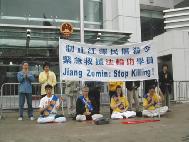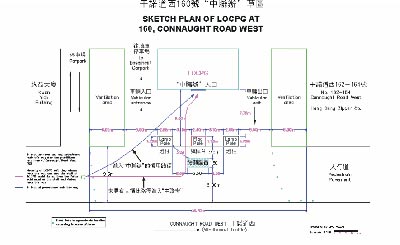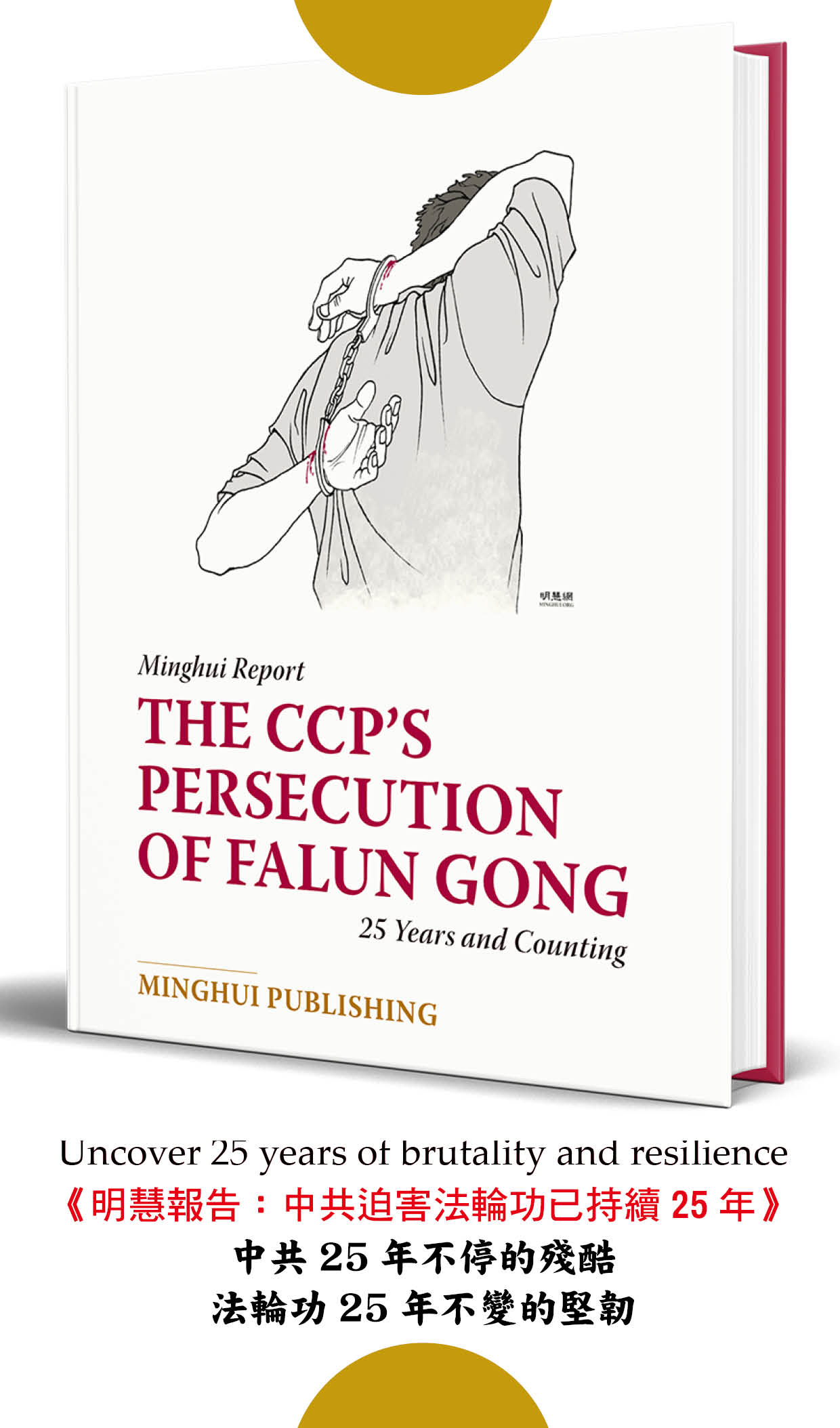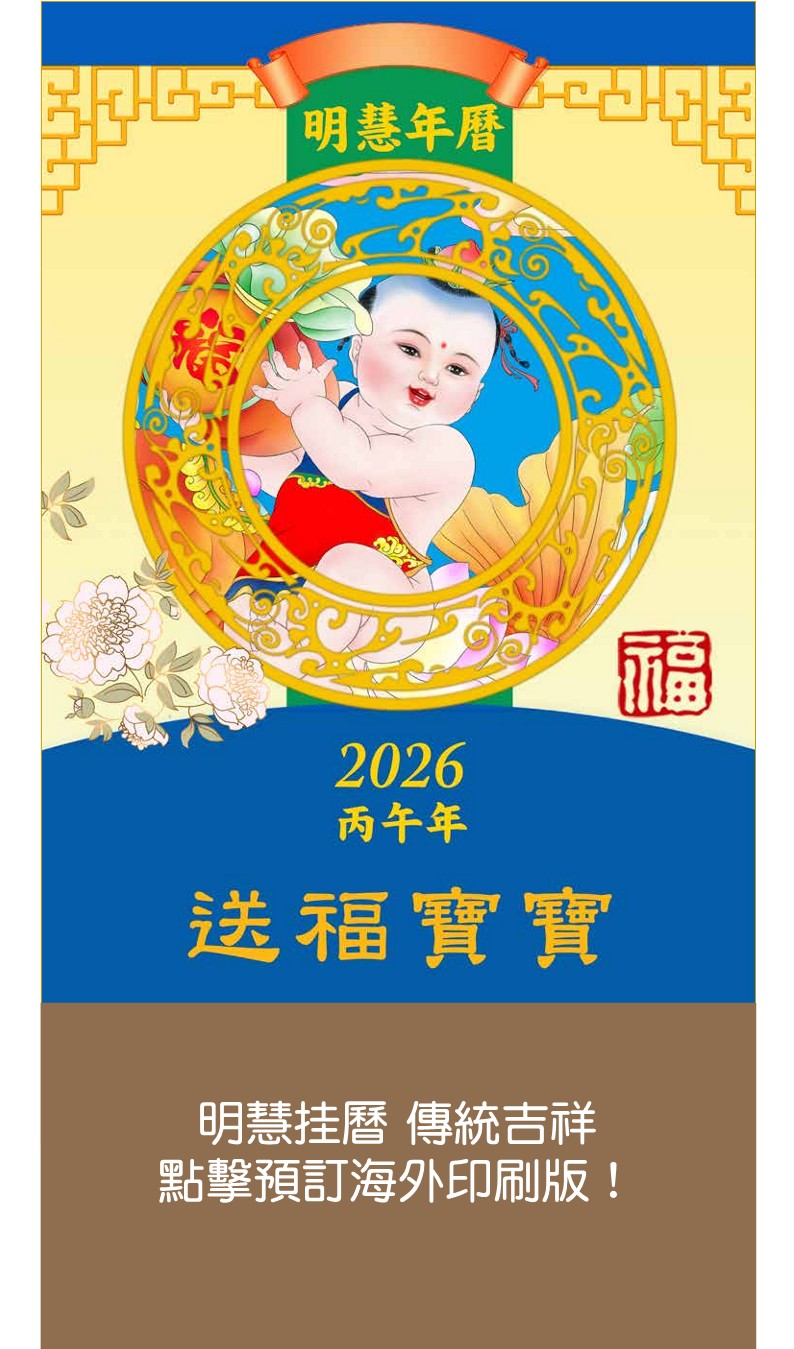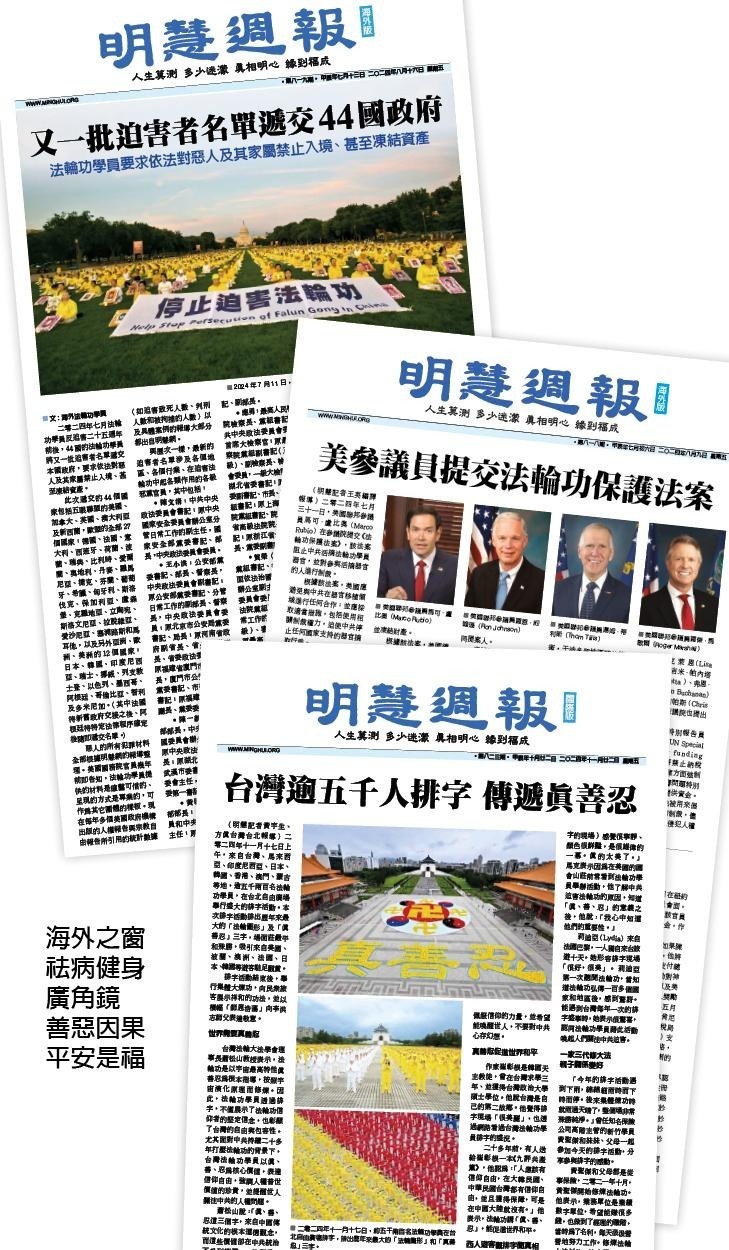香港警方誣告法輪功學員案辯方律師陳詞全文(中英對照)(上)
另,香港學員將於每天開庭的時間(一般為上午9時半至下午4時半)每半小時密集發正念。
以下是香港警方誣告法輪功學員案辯方律師陳詞全文。
香港警方誣告法輪功學員案辯方律師陳詞全文(中英對照)(上)
HONG KONG SPECIAL ADMINISTRATIVE REGION
WSC 548 OF 2002
DEFENCE SUBMISSION
CHRONOLOGICAL HISTORY
在香港特別行政區西區裁判法院
WSC 548 OF 2002
辯方律師陳詞
事發經過
1. At about 8.50 am on the 14th of March 2002 4 Swiss Fa Lun Gong (F.L.G.) practitioners set up a small stationary linear sit-in type demonstration in front of the flag podium of the Chinese Government Liaison Office at 160 Connaught Road West (no.160). By Hong Kong Standards, this pavement was very wide totally unobstructed and pedestrian traffic was very light. The demonstration included a hand held banner, a mat stating "Switzerland" and (like all things Swiss!) was extremely neat a tidy. The demonstration was "aimed at" the government of China and its positioning was "symbolically perfect" (i.e. directly opposite the flag podium of the government to whom the protest was directed). The "layout" can be fixed exactly on the scale plan exhibited. There was over 2 metres of clear pavement in all sides of the demonstration area. (2-3 metres on the office(s) side and 5 to 6 metres on the road (N.) side). The demonstrators had no reason to believe that they would embarrass or inconvenience anybody or anything except the conscience of the government against whose activities they were seeking to exercise the H.K. right to demonstrate. Early video and photos of this demo (prior to about 10.00 am) show it to have been colourful but quiet and that tranquillity, peace, calm, and order prevailed. However there was a buzz of official resentment and activity at no.160.
1. 在2002年3月14日,上午八點五十分左右,四名瑞士法輪功學員在幹諾道西160號中央人民政府駐港聯絡辦公室(160號)門前的旗桿台前細小範圍內排坐成一行,進行靜坐示威行動。根據香港的標準,這條人行道很寬闊,完全沒有障礙物,而且行人往來量很少。這次的示威行動包括了一個手持的橫額,一張地席寫著「Switzerland(瑞士)」,(就像所有瑞士的東西都有「瑞士」字樣),而且他們極之整齊。這次「示威行動」針對」中國政府,而請願者選擇的位置具「理想的象徵意義」(就是直接對著抗議所針對的政府的旗桿台)。請願者的「分布」可以精確地顯示在所附按比例縮小的展示圖。在請願範圍的四周都有超過兩米闊、且無障礙的人行道(在靠中聯辦的一側(南)有兩至三米,在靠路(北)邊有五至六米),除了他們這次在香港的請願行動所針對的(中國)政府的良心之外,這些示威者沒有理由相信他們會引起任何人物的尷尬和不便。早前有關這次示威行動的錄影帶和圖片(上午十時之前)顯示出這次行動富有色彩而又安靜,籠罩著安寧、和平、冷靜而有秩序的氣氛。但官方的怨恨與行動帶來的擾攘也在160號出現。
2. That "buzz" had begun with a security guard from no.160 taking the view that the demo. was too close to his podium. He was accustomed to the F.L.G. demos being tolerated and "penned in" only to one side outside no.162. During the next hour a named official from no.160 (who had been previously supplied with the private phone number of Mandarin speaking senior police) repeated his complaint to the local police on 5 separate occasions. Despite this show of concern, that official did not make a witness statement or give evidence to the court.
2. 這些「擾攘」始於160號護衛的意見,他認為這次請願行動的地點太接近旗桿台。他只習慣於容忍法輪功的請願行為被「攔到」162號外人行道的一旁。接著下來的一個小時,在160號的一位被指名的官方人員(他有警方早前所提供,能說普通話的高級警務人員的私人電話號碼)重複向本地警方投訴了5次。即使是如此地關注事情,這位官員卻沒有做出證人聲明或提供證據給法庭。
3. Just before 9.00 am the superintendent at Western Police Station received news of the official's complaint. The superintendent jumped to deal with this possible pavement obstruction. He shelved his routine 9.00 am Briefing and immediately rushed to the scene. By about 9.10 am there was a large number of police "milling about" outside no.160. The police numbers grew and grew until there were many more police than demonstrators.
3. 在上午差不多九點鐘,西區警署的指揮官收到有關官員投訴的消息。這位指揮官立即出來處理這件可能阻礙人行道的案件。他擱下自己例行的九點鐘訓示會,立刻趕到現場。到了上午九時十分,160號外面已經有大量警察「來回打轉」。警察的人數不斷地增加直至到警察的人數比示威人士多出許多。
4. The police embarked on a serious of potentially confrontational and puzzling acts. First they blocked off the pavement access to the podium with iron railings (this was the very access, so it is said, that workers and visitors to 160 liked to use; now only the "dangerous" vehicular access could be used). They than "penned in" the demonstrators to E and West. Then they "penned back" the media and curious citizens to the E leaving a 1-2 metre gap of pavement next to the road for passers by; later they put a similar barrier to the West (at the border of 160 and 162).
4. 警察展開了一連串帶對抗性和令人費解的行為。首先,他們用鐵馬封鎖了通往旗桿台的人行道(這就是那條據說員工和訪客到160號時喜歡使用的通道;現在遭封鎖後,只有那條「危險」的行車道可供使用)。然後他們把示威者在東、西兩邊「攔住」,接著他們把傳媒和好奇的市民「攔到」東邊,在路邊留下1-2米寬的間隙讓人行通過;其後,他們在西邊(在160和162的交界處)也放置了鐵馬。
5.The superintendent addressed the press and media. They could only listen by standing in the E vehicular access to no.160. The police spoke to the foreign demonstrators. They cooperated by showing their Swiss passports. All their passports and visas were in order. Never-the-less and for no apparent reason (their being no "black-list" of F.L.G. in H.K.) the police wrote down particulars from their passports. The police realized they were foreigners but did not ask them what their native language was. Although this had not been asked, an interpreter was brought to the scene by the police (in the presence of the media). The police then discovered that the interpreter did not speak the language of the foreign demonstrators. They continued to use this interpreter (again in the presence of the media) despite their knowledge that she did not speak the language of these foreigners.
5. 那位指揮官向記者和傳媒發表講話,他們只能在160號東邊的車輛入口旁站著聆聽。警察跟外國的示威者說話。他們(外國的示威者)合作地出示他們的瑞士護照。他們全部的護照和簽證都是有效的。不過在沒有明確的原因下(在香港沒有法輪功的「黑名單」的情況下),警察抄錄了他們護照上的資料。警察知道他們是外國人,但卻沒有詢問他們的母語是甚麼。雖然警察沒有詢問請願者以上的問題,但他們(在傳媒面前)把一位翻譯員帶到現場。警察隨即發現翻譯員使用的並不是這些外國示威人士的語言。即使如此,他們繼續使用這位翻譯員(同樣是在傳媒面前)。
6. The police then embarked on a series of legally puzzling quasi-RIOT ACT type readings out to the demonstrators. The readings contained a threat, that further action (eventually removal and arrest) may be taken, and an inducement, that this may be avoided if the demonstrators moved to outside 162. School teachers might describe this as giving naughty pupils several "last chances" but in the grown up world, these "warnings" have little legal basis, they were "interpreted" in the wrong language, and this all went on in front of the media. The foreign demonstrators reacted by pointing out that they were causing no obstruction and were doing nothing wrong and would not move. This is all in the police video/audio tapes.
6. 接著警方向示威人士展開了一連串在法律上令人費解,類似暴動法例式的宣讀。這些宣讀帶有一個恐嚇,就是可能採取進一步行動(最終被搬走和拘捕),和一個誘惑,就是如果這些示威人士移到162號外面,可避免警方的行動。學校老師們可能會形容這是給調皮學生們的數次「最後機會」。但在成年人的世界裏,這些「警告」欠缺法律基礎,且被「翻譯」成錯用的語言,而所有這些都在傳媒面前發生。那些外國示威者指出他們沒有造成阻礙,沒有做錯任何事,所以不會離開。所有過程都記錄在警方的錄影/錄音帶中。
7. By 12.30 pm massive numbers of police (including P.T.U. units) had been stood by. The tranquillity, space and peace which had prevailed before the arrival of large number of police had been replaced by metal barricades, police press conferences, police vehicles (some on the pavement), 2 police video teams with step ladders etc. All this reactive activity should have amazed the foreign visitors. We hope "over policing" of small matters is not becoming a feature of H.K. life. The visitors kept quiet and sat tight. At about 1.10 pm they and their local supporters, were seized using a technique which relies on causing pain to release a demonstrators grip. No formal cautions and no NTPIC were ever given to the suspects. They resisted being seized, said they had obstructed nobody, and said they should not be arrested.
7. 到了中午十二點半,大批警員(包括機動部隊)都準備就緒。在大批警員未到場前那種安靜、空間感與和平的氣氛,已被鐵馬、警方的記者招待會、警車(部份停泊在人行道上)、兩組攜帶踏腳梯的警方攝錄隊等所取代。所有這些反應的行動肯定會讓外國訪客感到驚訝。我們希望「警方的小題大做」不會成為未來香港生活的一個特徵。那些訪客保持冷靜並且緊密地坐著。大約到了下午一時十分,他們和他們的本地支持者被警方採用使示威者感到疼痛而鬆手的方法抓捕,而警方沒有給嫌犯正式的警告或正式的拘捕令。示威者抗拒警方抓捕,指出他們並沒有阻礙任何人,以及他們不應該被拘捕。
SIGNIFICANT FACTORS
重要因素
8. To discover the true factors precipitating the seizure of so many peaceful people of good character, the overall history and political background of this particular area of pavement must be carefully examined. The government have demonstrably recognized the relevance of this complex background. The government has seen fit to instruct 2 very senior government Counsel to present their case. They (like defence counsel) have virtually no professional experience of doing pavement obstruction cases. They must be here for other reasons. We hope it is solely because there is an obvious and relevant political and constitutional aspect to this case. F.L.G. is unlawful in Mainland China. Any police force of a separate system but of the "same country" will naturally be tempted to react negatively to F.L.G. exercising a legal right to demonstrate here (in the face of the mainland office) which would be illegal in the mainland. Asian people (particularly those with reduced democracy) do feel uncomfortable in the presence of a direct visible challenge to authority. H.K. police have got into the (bad?) habit of placing humiliating cage like metal fences around peaceful sitting demonstrators (see S.C.M.P. 2/7/02). None of our constitutional documents suggests that free expression must be made from a quasi-caged and humiliating position.
8. 我們要仔細探討中聯辦門外人行道的政治背景及整個歷史,才能發現致使這眾多品格優良的和平人士被拘捕的真正原因。這個政府亦展現出他們承認這個複雜背景的相關性,政府認為委派兩名很資深的檢控官去打這場官司的決定是合適的,他們(就像辯方律師)實際上沒有處理過阻街案件的專業經驗,他們到來一定是另有原因。我們認為政府的決定,主要是因為本案明顯地觸及政治和憲制這兩個方面。法輪功在中國大陸是「不合法」的,一個屬於「同一國家」但有另外體制的地方的警方,對法輪功在香港行使法律賦予的權利(當著大陸辦公室的面)示威這種在中國大陸被視為「非法」的舉動,自然地會被誘使對法輪功作出負面反應。亞洲人(尤其是那些沒有享受太多民主的人)面對向當權者作出的直接及公然的挑戰都會感到不自在。香港警方已經養成把類似帶侮辱性的鐵欄之類的牢籠圍住和平靜坐的示威者的(壞?)習慣(見S.C.M.P.2/7/020)。在我們任何一份憲制文件上,都沒有指出自由表達意見一定要在類似牢籠和受屈辱的狀態下進行。
9. The developed, obliging and immediate police response to official complaints from no.160 has a direct relevance to this case. The police have not troubled to bring a single "obstructed" witness to court. They have not produced a single truly "independent bystander". This is dangerously arrogant. The police know how highly such a witness would be regarded by the court when it comes to proving an inherently controversial offence which was flatly denied at the time by the defendants. The police may be hoping that the political climate re F.L.G. is such that the court will automatically accept whatever the police say and they the police need not trouble to produce independent confirmation.
9. 警方對160號發出的官方投訴,所形成的服從式而即刻的回應,與本案直接相關。警方完全無意傳召任何「受到阻礙」的證人出庭,他們沒有提供任何一個真正「獨立的旁觀者」,這是危險地自大的態度。警方知道在證實一個被辯方當場斷然否定的本質上具爭議性的指控,法庭會高度重視這一類證人。警方也許希望圍繞著法輪功的政治氣候已足夠讓法庭自動地接受他們的任何說法,警方因此不需要大費周章去提供獨立的證詞。
10. Those who serve in an authoritarian structure (e.g. police, security offices etc.) are inevitably susceptible to the mind set encapsulated in the Confucian parable about a despot who tested the loyalty of his subjects by pointing to a deer and calling it a horse; his people were not minded to contradict him even through everyone knew it was a deer that their leader was pointing to. Of course, the line between a demo. that may cause obstruction and one that may not is much finer than that between a horse and a deer. However these officers are likely to be pre-disposed to see any F.L.G. demonstration not previously tolerated/located by police as a potential obstruction. However it is hard evidence/and not the opinion of police officers, (however senior), which must satisfy the court. There is some arrogance in presenting this case involving a right to demonstrate without troubling to obtain any independent evidence from ordinary citizens. The police, like all other citizens are entitled to their own opinions privately held. Their subjective beliefs that this demo. constituted a potential obstruction has not been shown to have been based on reasonable grounds by any objective evidence. All the evidence has come from police and security men from 160. This creates an obvious appearance of bias.
10. 儒家的寓言中有一個故事是關於一個暴君為了檢驗隨從對他的忠誠,於是指鹿為馬,雖然隨從們每個人都知道他們的領袖指著的是一隻鹿,但他們並沒有異議。而那些在極權架構內服務的人(如警察、安全人員等)無可避免地容易墮入故事中隨從的思想傾向。當然衡量一個示威行動會否造成阻礙的界線,比分辨一隻馬和一隻鹿要更為細緻。然而,這些人員容易先入為主地將任何未經警方容許或指定位置的法輪功示威視為潛在的阻礙。但是,法庭需要的是真憑實據,而不是警員(無論多高級)的意見。在本案聆訊中,涉及到請願權利時,控方有點自負,完全無意提供來自普通市民的獨立證詞。就像其他公民一樣,警員有權擁有他們個人私自的意見。他們認為這次示威行動造成潛在阻礙的主觀看法,並不是根據任何客觀證據所得出的合理結論。所有的證據都是來自警察和160號的護衛員,這造成了明顯偏見的表現。
11. The result of this police altitude is that/apart from the irrelevant opinions of police officers e.g. an F.L.G. might trespass, there might be a breach of the peace, approaching workers might be intimidated, there might be recurrence) there is no area of the potentially opinionated live witness evidence of potential obstruction that is not completely destroyed by the mathematical accuracy available from the scale plan, the 4 hours plus of video/audio material and the photographs illustrating the history of that stretch of pavement. The prosecution are now faced with (a) a wide lightly travelled pavement whose history shows flexible tolerance of acceptable clutter and whose future shows no police objection to a very substantial narrowing of the existing pavement. (b) photos and early videos which show that the flag podium was never "blocked" by the demonstrators. (scale plan proves this).
The result is that the prosecution have (towards the end of their case) been asking witnesses if the demonstrators might have obstructed persons who take straight line routes on H.K. pavements! They have recognised that without that proposition, they have no case. Such a mythical person, if he ever existed, (the "straight liner") would not survive long in H.K.
11. 警員這種態度的結果(除了警員作出多個不相干的意見,例如一個法輪功學員可能擅自進入;可能會破壞和平;走近的員工可能感受到威脅;同樣事情可能會再次發生),使得可能是預先商定的目擊證人所提供的潛在阻街的證據的每個方面,都徹底地被比例平面圖所提供的精確數字、超過四個小時的影音證物以及表現這一段行人路的歷史的圖片一一推翻。控方現在面對以下兩點:(a)一條寬闊且人流稀少的人行道,其過去對可接受的雜物表現靈活的容忍度,其未來則顯示警方沒有就這條人行道被大幅度收窄而提出反對;(b)圖片和早先的錄影帶顯示出旗桿台並未被示威者「阻塞」(比例圖證明了這一點)。
結果,控方(在陳述案件接近尾聲時)要向證人詢問,示威者會否對在香港行人路上想走直線的人造成阻礙!他們知道要是沒有這個論點,他們的訴訟就不成立了,這個神話式的人物(那個「走直線的人」),如果真的存在的話,不會在香港生存得很久。
12. This proposition cannot survive critical analysis in a H.K. setting. Some examples make the point. Among those we encounter on a regular basis are workmen unloading or piling goods on the pavement; enthusiastic volunteers seeking flag day donations; part-time workers distributing leaflets to persuade us to patronize a new restaurant or to entice us to purchase consumer items; a group of old friends whose chance encounter develops into a twenty-minute conversation right in the middle of the pavement. H.K. is still humane enough to tolerate, for periods of up to 12 hours, established "prostrate beggar positions" on the pavement necessitating pedestrian diversions in busy locations. Cake workers stop in mid-pavement with a banner to protest a loss of jobs. Teenage girls gather to gossip on the pavement whilst waiting for a friend who is 1 hour late. These last few weeks hundreds, sometimes, thousands of Hong Kong resident stood or sat on pavements watching world cup games on large video screens, blocking not just part, but frequently the whole, of the pavement. But understanding residents of this modern metropolis did not insist on walking in straight lines or even their "usual" route, they made small diversions around the groups of people or took an alternative route. The (usually) young "soon to be marrieds" set up semi-permantly on the pavement at L.G.4. We do not send for the P.T.U. We smile and pass by.
12. 這個論點在香港的環境裏不能抵禦嚴謹的分析,一些例子已證實了這一點。我們日常接觸到的例子,如工人在人行道上起卸和堆放貨物、熱心的志願工作者在賣旗日向行人賣旗、兼職者派發傳單遊說行人光顧一間新的酒樓或吸引行人去買消費品、一群老朋友在人行道上偶遇演變成二十分鐘的街頭對話。香港到現在仍然會基於人道,容忍有人在可以導致行人必須繞道而走的情況下,在不超過十二小時的期限內,在繁忙的人行道上維持一個「乞丐俯臥的姿勢」。餅店工人停在路中心,打著橫幅抗議失業。少女們在路上一邊談天,一邊等待遲到了一個小時的朋友。最近的幾個星期,成百上千的香港市民站在或坐在行人路上,觀看大銀幕上的世界杯比賽,他們很多時候阻塞的不只是部份人行道,而是整條人行道。但這個現代都市通情達理的居民,並沒有堅持要走直線或者是維持他們「慣常」的路線,他們繞過了人群,或採用另外路線。對於那些「好事近」的(通常是)年輕人,在L.G.4的行人路上半永久擺設,我們不會派出機動部隊,我們會帶著微笑地經過。
13. Yet none of the persons in these few examples are protected by the Basic Law and International Covenants. The accused in this trial should be able to rely not only on the good will and courtesy of the residents of this civilized city that strives to be a world class metropolis; These accused have rights that are enshrined in and thus protected by the Basic Law, which guarantees their right to assemble and express their views, even if someone might have to make a very slight detour when walking on the pavement. Moreover in this case there is no evidence from anyone stating that he or she actually had to take a few extra steps. The difference between the examples and this case is that F.L.G. had a "political" message and they were not given the pavement tolerance they are entitled to. The "face" of no.160, the local police and their need to appear to be in control has affected their judgment.
13. 但以上幾個例子中所涉及的人們,都是沒有受到基本法和國際公約所保護的。而本次審訊被指控的人,不單可以倚賴來自這個爭取成為世界級大都會的文明社會中人民的善意與禮待;即使有人可能在路過這條人行道時,需要作出輕微的繞道,這些被指控的人所擁有的權利是被高高列在基本法中,因此受到基本法的保護,保證他們的集會權利與表達意見的權利。並且,在本案中亦沒有任何人提出任何證據,表示他/她確實因為避開這些請願者而多走幾步路。以上列舉的例子與本案的分別,在於法輪功帶有的「政治」信息,與及他們沒有被給予應有的使用人行道的寬容度。由於160號的「面子」、本地警察的「面子」與其需要表現得對一切事情都在掌握中等因素,都在影響著他們的判斷。
14. Hong Kong residents are accustomed to demonstrations sometimes disrupting the normal flow of traffic. They walk around a demonstration site and sometimes wait for the participants of a demonstration to walk by. Because the right to freedom of expression and the freedom of speech and the right to demonstrate are longstanding rights in H.K. Law, residents here have never been intimidated by peaceful demonstrations. The police had no need to attempt to divert and side track this small demonstration to a place on the same pavement but less conspicuous to those they wished to demonstrate to (i.e. 162). Had some implicit but unexpressed arrangement been come to between the police and the complainant at 160? The confusing events of 25/8/01 and 10/11/01 could be thus explained. Was there something sacrosanct about the big wide empty pavement outside 160? Why was the simple solution of "unblocking" the perceived blockage to the podium not dealt with by asking the Swiss to move 2 or 3 metres further away from the podium? Small wonder that the F.L.G. felt persecuted.
14. 香港市民已經習慣於示威活動可能有時會影響到正常的交通運作的情況。他們繞過示威地點,有時也會等待這些示威的參與者路過。因為表達自由、言論自由的權利以及請願權利都是一些長久以來在香港法律下所保障的權利,這裏的居民從來都沒有對和平示威活動感到受威脅。警方沒有必要嘗試去把這次的小型示威轉移到同一條人行道另一處的地方(也就是162),好讓被抗議的人看來不太顯眼。警方和160號的投訴者之間,有沒有一些不成文的隱密安排?這樣2001年8月25日與11月1日的混亂事件就可以得到解釋。在中聯辦門前的一片寬闊無阻人行道上,是否有著神聖不可侵犯的意味?其實要「除去」旗桿台前所覺察到的障礙很簡單,只需要要求那些瑞士人進一步移離旗桿台2至3米便行,為甚麼有一個這麼簡單的辦法卻不採用?難怪法輪功感到被迫害。
15. Somehow in this case, although it must now be acknowledged that there was plenty of space to pass in front of, behind and on either side of the four Swiss demonstrators and those F.L.G. members who supported them, the prosecution now insist that there was an obstruction because it was theoretically impossible for some hypothetical person to walk along the pavement to a position directly in front of the small group of protestors (occupying a site about 3 meters by 2 meters of a section of pavement measuring overall 30 meters by 9.5 meters) and then make a right angle turn so that they could walk as close as possible to the flag pole directly to the front door of the LOPCG.
15. 雖則在本案中,現在必須承認在這四名瑞士示威者和那些支持他們的法輪功學員的四周,都有大量的空間可以讓行人通過,控方現在仍堅持說這是一個阻礙,因為在理論上一些假設的人士是不可能沿著人行道一直走到這小撮抗議者跟前(他們在一條30米長9.5米寬的人行道上,只是佔用了一處3米長2米寬的地方),然後再作直角轉向,好讓他們最大限度貼近正對著中聯辦前門的旗桿台。
16. The absurdity of this proposition was illustrated by the prosecutor re-examining a witness to ask if, for a person emerging for his lunch break, the shortest and straightest route to the pavement would be through the flag podium. This is cloud cuckoo land because
(1)all normal lunch goers use the Des Voeux Road exit.
(2)to attempt to cross Connaught Road opposite the podium is unlawful.
(3)It is a no stopping area (cannot get taxi etc).
(4)It is not a direct route to anywhere (except to an empty piece of pavement).
(5)No normal lunch goer would come out just to visit an empty piece of pavement. All must go East or West to get anywhere and in fact, demonstrably, they do use the E or W entrances.
Even if such an odd fellow existed he could go through the podium and could still pass by either side of the demonstration. (9 foot plus 9AP) This "odd fellow" or even a legion of them cannot begin to establish a prima facie care of obstruction. In fact, no such witness was called. Perhaps he does not exist.
16. 這個論點的荒謬處可以從檢控官再次盤問證人時,所問的問題中顯示出來。檢控官問道,如果有人要出去吃中午飯,最短和最直接的途徑就是通過旗桿台。這是子虛烏有,因為:
1.所有正常去用午餐的人都會用德輔道的出口。
2.嘗試穿越在旗桿台對面的幹諾道是違法的。
3.這裏沒有停候處(不能上下的士等)。
4.這不是通往任何一處的直接路線(除了通往一段空無一物的人行道之外)。
5.沒有任何一個正常的去用午餐的人走出來僅僅為的是看一段空無一物的人行道。無論到哪裏去,所有人都必須向東面或西面走,而實際上,可以看到他們也用東面或西面的入口。
即使會有一個行為如此怪異的人存在,他仍然可以通過旗桿台,再從請願範圍(9英尺加9AP)的兩旁的任何一側走過。這個「怪異的人」或者甚至是一大批這種人存在,都不能夠令阻礙的表面證據成立。實際上,並沒有這類證人被傳召;或許他並不存在。
(上,待續)
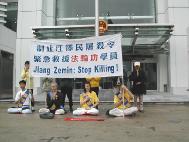
圖一:請願學員並沒有阻塞任何通道。



